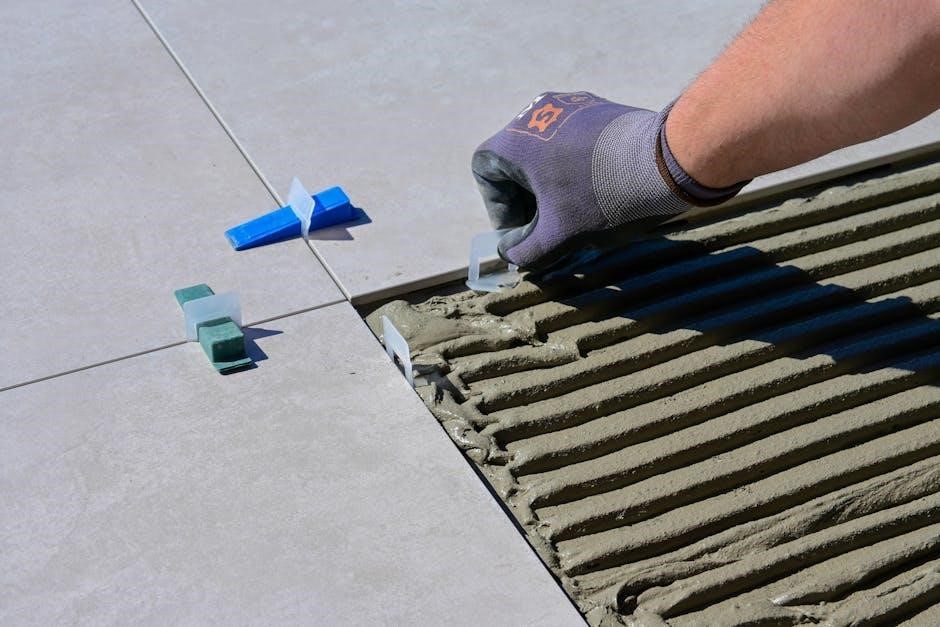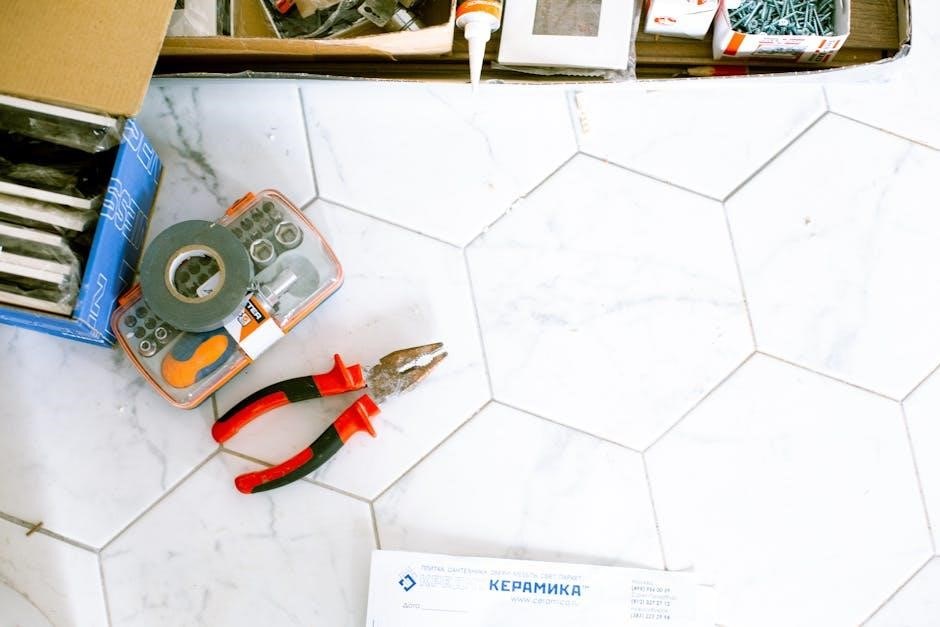Henry 430 VCT Floor Adhesive Instructions: A Comprehensive Guide
This guide provides detailed instructions for using Henry 430 ClearPro VCT adhesive. Learn the proper steps for VCT installation‚ ensuring a successful project. From surface preparation to final placement‚ follow these guidelines for optimal results in residential and commercial settings.
Product Overview: Henry 430 ClearPro VCT Adhesive
Henry 430 ClearPro VCT Adhesive is a premium‚ clear thin-spread adhesive meticulously engineered for the secure installation of vinyl composition tile (VCT) in both residential and commercial environments. This high-performance adhesive distinguishes itself with its exceptional clarity‚ allowing for a clean and aesthetically pleasing finish‚ particularly beneficial when working with light-colored or patterned VCT.

Formulated to provide a strong and durable bond‚ Henry 430 ClearPro ensures that VCT installations remain stable and long-lasting‚ even in high-traffic areas. Its thin-spread consistency facilitates effortless application‚ promoting efficient use of the product and minimizing waste. The adhesive’s formulation is designed to offer excellent grab and workability‚ enabling precise tile placement and adjustment during installation.
Moreover‚ Henry 430 ClearPro is crafted to meet stringent industry standards for volatile organic compound (VOC) emissions‚ contributing to improved indoor air quality. This makes it an environmentally conscious choice for projects where health and sustainability are paramount. Its versatility and reliability render it a preferred option for professionals and DIY enthusiasts alike‚ guaranteeing a professional-grade VCT installation with enduring performance.
Intended Use: VCT Installation in Residential and Commercial Settings
Henry 430 ClearPro VCT adhesive is specifically formulated for the installation of Vinyl Composition Tile (VCT) across a wide array of residential and commercial settings. In residential applications‚ it’s ideal for kitchens‚ bathrooms‚ basements‚ and other living areas where VCT flooring is desired. Its strong bond ensures durability in family homes‚ withstanding daily wear and tear from foot traffic‚ spills‚ and furniture.
In commercial environments‚ Henry 430 ClearPro is well-suited for high-traffic areas such as retail stores‚ offices‚ schools‚ hospitals‚ and public buildings. Its robust adhesive properties make it capable of handling the demands of heavy foot traffic and frequent cleaning‚ ensuring a long-lasting and professional flooring installation. The adhesive’s compatibility with various subfloor types makes it a versatile choice for different commercial construction projects.
Whether you’re renovating a home or constructing a commercial space‚ Henry 430 ClearPro VCT adhesive provides the reliable performance and ease of use necessary for achieving a successful and durable VCT flooring installation. This ensures that the flooring remains securely in place‚ maintaining its appearance and functionality for years to come.
Incompatible Flooring: Avoiding Solid Vinyl and Other Backed Structures
It is crucial to understand the limitations of Henry 430 ClearPro VCT adhesive to ensure a successful flooring installation. This adhesive is specifically designed for Vinyl Composition Tile (VCT) and is not suitable for use with certain other types of flooring materials. Most notably‚ Henry 430 should never be used with solid vinyl tiles or planks. Solid vinyl has different expansion and contraction properties than VCT‚ which can lead to adhesive failure‚ bubbling‚ or warping of the flooring.
Additionally‚ avoid using Henry 430 with flooring that has vinyl-backed structures. The backing material can react negatively with the adhesive‚ preventing a proper bond. This includes certain types of resilient flooring‚ such as some linoleum or specialty vinyl products. Always consult the flooring manufacturer’s recommendations to determine the appropriate adhesive for your specific material.
Using the wrong adhesive can compromise the integrity and longevity of your flooring installation. It’s essential to verify compatibility before starting the project to prevent costly mistakes and ensure the best possible results. Choosing the correct adhesive is a critical step in achieving a durable and aesthetically pleasing floor.

Acclimation: Temperature and Humidity Requirements
Proper acclimation is paramount for a successful VCT installation using Henry 430 ClearPro adhesive. Acclimation refers to the process of allowing both the flooring material and the adhesive to adjust to the environmental conditions of the installation area. This ensures that expansion and contraction occur before installation‚ minimizing issues later. Maintaining consistent temperature and humidity is key to achieving a durable and aesthetically pleasing result.
Before starting any work‚ ensure the installation area is climate-controlled. The temperature should be within the range specified for Henry 430 adhesive‚ typically above 65°F (18°C). Humidity levels should also be within an acceptable range‚ as excessive moisture can interfere with the adhesive’s bonding properties.
Both the VCT tiles and the Henry 430 adhesive should be stored in the installation area for a sufficient period‚ typically at least 48 hours before installation. This allows them to equilibrate to the room’s temperature and humidity. Proper acclimation prevents issues like gapping‚ warping‚ or adhesive failure. Ignoring this step can lead to significant problems down the line‚ compromising the integrity of the flooring.
Optimal Temperature Range: 65F (18C) or Above
Maintaining the correct temperature is crucial when working with Henry 430 ClearPro VCT adhesive; The optimal temperature range for both the adhesive and the installation area is 65°F (18°C) or above. This temperature threshold ensures that the adhesive maintains the correct viscosity and tack for proper bonding with the VCT tiles and the subfloor.
When temperatures fall below this recommended range‚ the adhesive can become too thick and difficult to spread evenly. This can lead to poor adhesion‚ resulting in loose tiles or other installation failures. It also extends the open time‚ which is the period the adhesive needs to sit before the tiles can be placed‚ potentially causing delays in the project.
Ensure that the subfloor and the VCT tiles are also at this temperature range before starting the installation. Use a reliable thermometer to monitor the temperature throughout the process. If the temperature fluctuates‚ take steps to stabilize it before proceeding. Failure to maintain the optimal temperature can compromise the quality and longevity of the VCT flooring installation.
Acclimation Duration: 48 Hours Before‚ During‚ and After Installation
Proper acclimation is paramount when using Henry 430 ClearPro VCT adhesive. To ensure successful installation‚ both the VCT tiles and the adhesive must acclimate to the installation environment for a minimum of 48 hours before‚ during‚ and after the installation process. This acclimation period allows the materials to adjust to the room’s temperature and humidity levels‚ preventing issues like expansion‚ contraction‚ or bonding failure.
Before starting the installation‚ store the VCT tiles and adhesive in the room where they will be installed for at least 48 hours. This allows them to reach equilibrium with the room’s conditions. During the installation‚ maintain consistent temperature and humidity levels to avoid any disruptions to the adhesive’s performance. After the installation‚ continue to maintain these conditions for an additional 48 hours to ensure the adhesive properly cures and bonds the tiles to the subfloor.
Failure to acclimate the materials properly can lead to problems such as tiles lifting‚ gapping‚ or buckling. Always adhere to the recommended acclimation duration to achieve a durable and long-lasting VCT flooring installation.
Surface Preparation: Ensuring a Suitable Substrate
Proper surface preparation is crucial for a successful VCT installation with Henry 430 ClearPro adhesive. The substrate must be clean‚ dry‚ smooth‚ and structurally sound. Remove any existing flooring‚ adhesives‚ or contaminants such as dust‚ dirt‚ grease‚ wax‚ or paint. Thoroughly sweep or vacuum the subfloor to eliminate loose debris. Any imperfections‚ such as cracks or unevenness‚ must be addressed before applying the adhesive.
For concrete subfloors‚ ensure they are fully cured and free from moisture. Conduct moisture testing to verify the substrate meets the adhesive manufacturer’s requirements. If necessary‚ apply a suitable moisture mitigation system. Level any uneven areas with a self-leveling underlayment to create a smooth‚ flat surface. Wood subfloors should be structurally sound and free from excessive deflection. Repair or replace any damaged sections. Sand down any rough areas or protrusions to create a uniform surface.
A properly prepared substrate ensures optimal adhesion and prevents issues like tile movement‚ bubbling‚ or premature failure. Taking the time to prepare the surface thoroughly is an investment in the longevity and appearance of your VCT flooring.
Adhesive Application: Achieving Proper Coverage
Applying Henry 430 ClearPro adhesive correctly is essential for a strong and lasting bond with your VCT flooring. Use a notched trowel with the recommended notch size specified by the adhesive manufacturer. Apply the adhesive evenly across the prepared subfloor‚ holding the trowel at a consistent angle to achieve the proper spread rate. Avoid applying too much or too little adhesive‚ as this can compromise the bond.
Work in manageable sections to prevent the adhesive from drying out before the VCT is installed. Spread the adhesive in one direction‚ ensuring complete and uniform coverage. Pay close attention to edges and corners‚ as these areas are prone to lifting if not properly adhered. Periodically check the trowel for wear and replace it as needed to maintain the correct notch size. If the adhesive skins over before the VCT is placed‚ scrape it up and reapply a fresh coat.
Proper adhesive application ensures that the VCT tiles are fully supported and securely bonded to the subfloor‚ preventing movement‚ buckling‚ and other installation issues. Achieving proper coverage is key to a professional and durable VCT flooring installation.
Open Time: Waiting for Adhesive to Become Tacky
After applying Henry 430 ClearPro adhesive‚ it is crucial to allow the correct open time before placing the VCT tiles. Open time refers to the period the adhesive needs to sit and become tacky‚ allowing for a strong bond. The ideal open time can vary based on temperature‚ humidity‚ and subfloor porosity.
Generally‚ wait until the adhesive changes from a wet‚ liquid state to a tacky consistency. To test for tackiness‚ gently touch the adhesive with a fingertip. The adhesive should feel sticky and leave a slight residue on your finger‚ but it should not transfer excessively or feel overly wet. If the adhesive is still too wet‚ allow more open time;
If the open time is too long‚ the adhesive may dry out and lose its bonding strength. In such cases‚ remove the dried adhesive and apply a fresh coat. Following the recommended open time ensures optimal adhesion‚ preventing issues like tile movement or lifting. Always consult the adhesive manufacturer’s instructions for specific open time recommendations based on your environmental conditions.
Remember‚ patience during the open time is critical for a successful and long-lasting VCT flooring installation.
Placement of VCT: Timing After Adhesive Sets
The timing of VCT placement after the adhesive sets is crucial for a successful installation using Henry 430 ClearPro. After allowing the adhesive to achieve the proper tack‚ carefully position each VCT tile onto the prepared surface. Avoid rushing this step‚ ensuring accurate alignment and consistent spacing between tiles.
Once a tile is placed‚ firmly press it into the adhesive to ensure full contact. Use a hand roller or a flooring roller to apply even pressure across the entire tile surface. This step is essential for creating a strong bond and preventing air pockets.
Work in manageable sections‚ placing and securing tiles before moving on to the next area. As you progress‚ regularly check for any adhesive squeeze-out between tiles. If necessary‚ clean up excess adhesive with a damp cloth promptly to prevent it from drying and becoming difficult to remove.
After the entire floor is covered‚ allow the adhesive to cure fully according to the manufacturer’s recommendations. Avoid heavy traffic on the newly installed floor during the curing process. Proper timing and careful placement contribute to a durable‚ aesthetically pleasing VCT floor that will stand the test of time.
Safe Handling Instructions: Eye and Skin Protection
When working with Henry 430 ClearPro VCT adhesive‚ prioritizing safety is paramount. This section outlines essential precautions to protect your eyes and skin from potential irritation or allergic reactions. Always read and understand the product’s Safety Data Sheet (SDS) before use.
Eye protection is crucial. Wear safety glasses or goggles at all times to prevent accidental splashes or fumes from entering your eyes; If adhesive comes into contact with your eyes‚ immediately flush them with plenty of water for at least 15 minutes and seek medical attention.
Skin contact should also be avoided. Wear gloves made of a chemical-resistant material‚ such as nitrile or neoprene‚ to prevent direct exposure. If adhesive gets on your skin‚ wash it off immediately with soap and water. Avoid using solvents‚ as they can increase skin absorption. Prolonged or repeated skin contact may cause irritation or dermatitis in sensitive individuals.
In addition to eye and skin protection‚ ensure adequate ventilation in the work area. This helps to minimize exposure to adhesive fumes. By following these safe handling instructions‚ you can significantly reduce the risk of adverse health effects and ensure a safe working environment.

Recommended Safety Gear: Safety Glasses and Gloves
When installing VCT using Henry 430 ClearPro adhesive‚ safeguarding your personal well-being is paramount. Utilizing appropriate safety gear is not merely a suggestion but a necessity to minimize potential hazards. This section emphasizes the importance of safety glasses and gloves as essential protective measures.
Safety glasses are crucial for shielding your eyes from accidental splashes‚ airborne particles‚ and potential chemical exposure. Select safety glasses that provide a secure fit and comply with ANSI Z87.1 standards‚ ensuring adequate protection against impact and chemical splashes. Always wear safety glasses throughout the entire installation process‚ even during seemingly innocuous tasks.
Gloves are equally important for protecting your skin from direct contact with the adhesive. Choose chemical-resistant gloves made of nitrile or neoprene‚ as these materials offer excellent protection against the solvents and chemicals present in the adhesive. Ensure the gloves fit properly and cover your hands and wrists completely. Inspect the gloves for any tears or punctures before each use and replace them immediately if damaged.

By consistently wearing safety glasses and gloves‚ you significantly reduce the risk of eye irritation‚ skin sensitization‚ and other potential health issues associated with handling adhesives. Prioritize your safety and make these protective measures a routine part of your VCT installation process.
Indoor Air Quality: Potential Impact During Installation
During the installation of VCT using Henry 430 ClearPro adhesive‚ it’s important to be mindful of the potential impact on indoor air quality. Adhesives can release volatile organic compounds (VOCs) during application and curing‚ which may temporarily affect the air quality within the work area and surrounding spaces. Understanding these potential effects and implementing appropriate mitigation strategies is crucial for maintaining a healthy environment.
The release of VOCs can vary depending on factors such as the adhesive’s formulation‚ the size of the installation area‚ ventilation rates‚ and ambient temperature. While Henry 430 ClearPro is designed to be a low-VOC adhesive‚ it’s still advisable to take precautions to minimize any potential impact on air quality.
Adequate ventilation is key to dissipating VOCs and maintaining fresh air circulation. Open windows and doors whenever possible to promote natural ventilation. If natural ventilation is insufficient‚ consider using mechanical ventilation systems‚ such as fans or air purifiers‚ to enhance air circulation. Ensure that the ventilation system is properly functioning and capable of exchanging air effectively.
In addition to ventilation‚ consider scheduling the installation during periods of lower occupancy to minimize exposure for sensitive individuals. Communicate with building occupants about the installation schedule and any potential odors that may be present. By taking these proactive measures‚ you can help mitigate the potential impact on indoor air quality and create a more comfortable environment during and after the VCT installation.